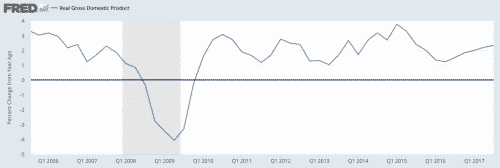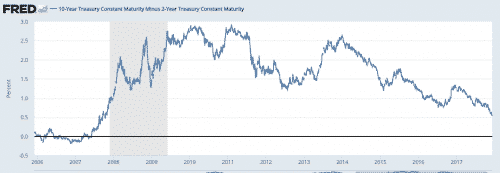As the Fed meets, expect expansion through 2018, but problems thereafter
I started writing this post last Thursday before the US jobs report came out and the point I was going to make initially was that I expected good things from that report on the heels of some pretty robust jobless claims reports and 190,000 private sector jobs in the ADP report. Moreover, while we can’t expect 3% growth in the US to last indefinitely, there are no signs of weakness in the real economy in the US – or in Europe or Japan for that matter. Given where we are right now, I think this expansion will continue through the end of 2018. And so, I want to talk about what that means in the context of my last post and recent BIS warnings on financial markets.
The macro backdrop is good
First, on the real economy, recessions don’t come out of nowhere. Generally, economic vulnerability has to be present – a ‘stall speed’ economy vulnerable to an economic shock. And then you need that shock to occur and have enough bite to push the economy into recession.
For example, the last big shock the US economy took was the drop in oil prices from over $100 in mid-2014 to $30 a barrel at the beginning of 2016. We saw a virtual halt in shale oil capital expenditure that had a measurable impact on GDP growth starting in early 2015, when prices had already fallen into the $50-60 range.
That’s when Continental Resources announced a cut to capex down to $920 million from $2.7 billion in 2015. And even the majors were cutting capital expenditure so much that as the year began analysts at Bernstein Energy were expecting a 38% sector-wide cut to capex in 2016. But this was the bottom for oil prices. And while we hit a low of 1.2% growth, year-over-year numbers never went into recession territory.
We would have needed another major economic shock – like an aggressive interest rate hike campaign – once we hit 1.2% to send the economy into recession. And if you recall, the Fed had been saying it was going to hike multiple times in 2015 and 2016. But the Fed slow-walked its tightening as the poor data came in, and eventually the economy recovered.
By contrast, in the decade before, the slowdown in the housing sector eventually proved too large to overcome and we had a financial crisis and recession. But even there, there was a big lag. House prices in the US actually peaked in 2005 and recession didn’t arrive until December 2007. So we had over two years of deceleration in the housing sector before the economy finally turned down. And I think this is important when thinking about where we go from here in this cycle.
Gavyn Davies, who does some good nowcasting to gauge where the economy is headed, recently published a piece in effect arguing that the economy has a low chance of recession for the next 12 months. Regarding the global economy, he writes, “it is important also important to recognise that the predicted path for activity, although slowing, remains above trend and above the consensus forecasts for next year. Therefore, while the “growth signal” for asset markets will be less robust than it has been this year, it will be far from sluggish…In the US, China and the EA, the probability of two negative quarters of GDP growth next year is currently shown to be less than 10 per cent.”
Dovish tightening – or what Mohamed El-Erian calls a beautiful normalization
The Fed has been tightening ever since the beginning of 2014. And while the initial announcement that the Fed would taper its purchase of Treasury bonds and mortgage-backed securities steepened the curve considerably in 2013, once the policy began in 2014, the curve flattened – and has been flattening ever since. The spread between 2 and 10-year Treasury bonds ended 2013 at 2.66% or 266 basis points. We are now below 60. So that’s 200 basis points of flattening in 4 years, an average of 50 basis points per year since the beginning of the tightening. I would call that a ‘beautiful normalization’ just like Mohamed El-Erian because it could have been considerably worse.
But, of course, while this has been a beautiful normalization for the real economy — bringing the headline rate of unemployment down to 4.1% while inflation is still below target —financial markets have become very rich. Markets are thinking about central bank policy as ‘dovish tightening’ – meaning a rate hike train that is predictable and that policy makers are eager to show will not destabilize the buoyancy of financial markets. Think of the policy as akin to Greenspan’s robotic 25 basis point hike train that began in 2004 during the housing bubble.
The problem, of course, is that Greenspan’s rate hikes continued for two years, through the 2005 peak in house prices and even after the yield curve had inverted in 2006. And those are basically the same pre-conditions we have now. The Fed is poised to raise rates this week and three more times in the next 12 months. And I don’t expect the Fed to deviate from their talking points when they hike rates tomorrow. But, if anything, the risk is to the upside —meaning that given what I know about the Fed’s reaction function and the pre-conditions for inflation, unemployment, and financial stability, we should expect four rate hikes in 2018 before we expect two.
The BIS is on the Warpath again
The big problem with these pre-conditions and why they mean we are in the most dangerous period in the business cycle is something Bank for International Settlements chief Claudio Borio recently gave voice to.
Echoing Hyman Minsky and his financial instability hypothesis where stability eventually breeds too much risk-taking and financial crisis, Borio sad, “
The vulnerabilities that have built around the globe during the long period of unusually low interest rates have not gone away. High debt levels, in both domestic and foreign currency, are still there. And so are frothy valuations.
What’s more, the longer the risk-taking continues, the higher the underlying balance sheet exposures may become. Short-run calm comes at the expense of possible long-run turbulence.
And yet again, the problem could be household debt.
Here’s the BIS on household debt in places like Australia, Canada, Norway, Sweden and Switzerland https://t.co/cjO5ggAhAY
— Edward Harrison (@edwardnh)
The big takeaways from the BIS warnings are twofold. First, we’ve been here before with the BIS warning us about debt and the potential for crisis. That was during the housing bubble. And the BIS proved right there, to devastating effect. We should take their warnings seriously then,
But even more importantly, the BIS warns that households’ responsiveness to debt shocks are asymmetrical. We cut back much more aggressively due to a shock than we add in consumption on the upswing. And that means that the downside risk from a debt shock are more severe and difficult to manage than the slow grind upward from consumption buoyed by increases in household debt.
Monetary policy plays an important transmission role here as the BIS pointed out a week ago:
From a macroeconomic stability perspective, one of the main issues for central banks is that of monetary transmission. Monetary policy could have asymmetrical effects in an economy with high levels of household debt, meaning that an interest rate hike would be more contractionary than an equally sized rate cut would be expansionary. Importantly, the asymmetry increases as the maturity of debt shortens, so that central banks in high-debt countries with a large share of adjustable rate mortgages could expect large contractions following small rate hikes, complicating post-GFC interest rate normalisation.
Conclusion
The stage is now set. We are well into the business cycle, with the real economy doing as well as it has done for the last decade, but also with financial assets at frothy levels. Against this backdrop, there is a dangerous releveraging driven by household debt and house prices.
The UBS Housing Bubble Index shows a number of cities with house prices at significant risk of a future correction pic.twitter.com/3dzXUDfPMU
— Edward Harrison (@edwardnh)
If central banks try and lean against these asset markets with interest rate hikes instead of through macroprudential means by “loan-to-value caps (on the borrower side) or credit growth caps (on the lender side) are designed to force borrowers and lenders to internalise the impact of large credit expansions on the probability of a systemic crisis” as the BIS suggests, you could see a financial crisis.
My baseline assumption now is for continued growth in the US, with the headline rate of unemployment dipping well into the 3% range in 2018, drawing a more aggressive response from the Fed than currently anticipated. After three rate hikes by mid-2018, the US yield curve should be near completely flat. And it’s at that point that the rubber hits the road. If the Fed continues to hike into those pre-conditions, I believe it will do so in an environment of slowing economic and credit growth with potentially large negative downsides for 2019 and beyond.


Comments are closed.